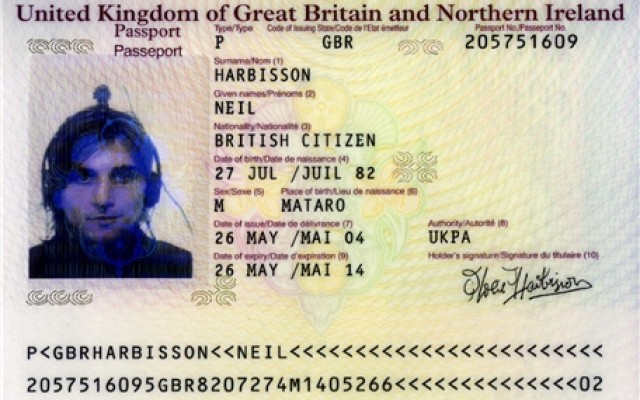
A Life With Complete Color Blindness
Neil Harbisson can’t see color. He never has. He was born with achromatopsia, a condition that only allows him to see in grayscale. Now think about that for a minute. Can you imagine a world where there is no color? It makes you realize how much color is tied to our reality, whether it’s the implied meaning of traffic lights and signs, the aesthetic of a harmonious color palette in the décor of a room, or even knowing the difference between a day with a blue sky or a grey one. Now while you’re wrapping your head around the concept of never perceiving color, let’s confuse your senses and let’s imagine you hear color. Give each color a sound that helps you identify what color it is. At first it’s a way to identify colors you can’t see. However in time, what at first appears as a way to compensate for a disability such as color blindness becomes a whole new sense and different reality, where places and the faces of people can sound musically pleasing or dissonant to the ear and when hearing a speech or a song translates into a cascade of colors. Take it a step further beyond visible light, where the sound of someone’s infrared footprint alerts you that they’re nearby, or you get migraines from the constant pitch of UV rays on a sunny day.

Neil Harbisson – the World’s First Cyborg
Welcome to the world of Neil Harbisson, who altered his body by having a chip implanted in his skull attached to an antenna containing a camera in front of his face to translate colors into sounds. Born in 1982 in Great Britan, Harbisson was raised in Catalonia, Spain and studied music and art. In 2003, he was introduced to cybernetics at a talk by Adam Montandon, who was a student at Plymouth University. They collaborated together on a project to develop a head-mounted sensor to translate color frequencies into sound frequencies. In the years after this initial project, he had collaborated with others to further develop the technology and eventually had a chip permanently attached to his skull, making him officially recognized as the world’s first cyborg in 2004. The definition of cyborg is a cybernetic organism, in this case, a human with enhanced abilities due to the integration of technology.

(Photo credit: Moon Ribas)
Now, Neil Harbisson has traveled the world, making appearances, giving presentations and performances and interviewed in many major media outlets. His TED talk, I listen to Color, has over 1.5 million views.
Disadvantages of Being a Cyborg

(image courtesy of Neil Harbisson)
Harbisson eventually discovered that being a real cyborg had its disadvantages. He had to fight for the right to renew his UK passport, as they would not allow a picture of him with electronic equipment on his head. He eventually won that right and his passport picture does include the antenna. Being a real life cyborg meant that the technology was now part of his body and could not be removed. While attending a demonstration in Barcelona, police believed he was filming it and broke his antenna off. In reaction to these struggles, Harbisson founded the Cyborg Foundation, along with his long-time partner, choreographer Moon Ribas, to research, create and promote projects that apply technology to the human body to extend and create new senses as well as help those human cyborgs running into the issues that arise when society questions this new paradigm.

Upcoming Blog Series From Our Neil Harbisson Interview
In this series of blog posts, our 2nd blog post is from our interview with Neil Harbisson. We focus on color in his world – how the colors were mapped to sounds, and how he identifies colors. Part 3 goes into a little more depth on what it’s like to hear colors, especially in challenging environments. Part 4 in the series is about what art education is like when you have complete color blindness, and blurring the lines between music, art and color. Part 5 will cover the latest enhancements to the technology and what projects he’s working on next. The last part in the series will explain how the technology is attached to him and discuss some of the personal challenges of being a human cyborg.
Part 2: Hearing Colors
Part 3: The Sound of Color Associations
Part 4: Colorblind Artist & Cyborg
Part 5: Beyond Hearing Color
Part 6: Life as a Human Cyborg



[…] part 2 of our 6 part series on Neil Harbisson, the world’s first cyborg, we interview him about how the technology that translates color into […]